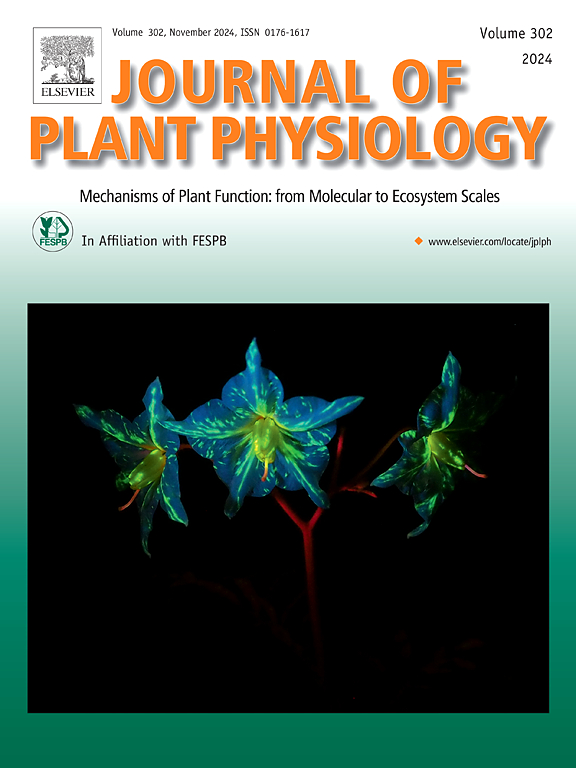铵(NH₄⁺)调节玉米碳代谢和同化物空间-昼夜分配,提高玉米生长和氮素利用效率
IF 4.1
3区 生物学
Q1 PLANT SCIENCES
引用次数: 0
摘要
氮(N)主要以硝酸盐(NO3−)和铵(NH4+)的形式被大多数植物吸收,以支持生长和代谢功能。然而,在不同氮形态下调节碳(C)同化分配的调控机制尚不清楚。本研究研究了5种氮素处理(T1 - t5)下玉米幼苗C代谢及其空间分布:T1,无氮(对照);T2, 1mm NO3−(唯一NO3−);T3, 1mm NH4+(单NH4+);T4, 0.5 mM NH4NO3(混合供氮);T5,移栽后10 d用1mm NO3−(NH4+→NO3−)替代1mm NH4+。NH4+处理引发了显著的生理和分子适应,如促进生长,改善光合性能,增加蔗糖和淀粉积累。这些碳水化合物水平的升高与蔗糖代谢酶(SuSy、SPS和INVs)和淀粉代谢酶(AGPase、SS、AMY和BAM)活性的增加密切相关,同时与蔗糖代谢(ZmSPS1、ZmSuSy1和ZmINVs)、蔗糖转运(ZmSWEET14、ZmSUT2和ZmSTP2)和淀粉代谢(ZmSS1、ZmAGPase1、ZmAMY1和ZmBAM1)的关键基因的上调密切相关。空间和日分析揭示了C在叶片、根和叶鞘间分配的动态模式。这些发现促进了我们对不同形态的氮,特别是NH4+,如何调节C代谢和芽根分配,促进汇组织碳利用,提高植物对氮波动的适应能力的理解。未来的研究将集中在探索不同玉米基因型在田间条件下的这些适应机制,以提高变氮环境下的氮素利用效率和生产力。本文章由计算机程序翻译,如有差异,请以英文原文为准。
Ammonium (NH₄⁺) regulates carbon metabolism and spatial–diurnal assimilate partitioning to improve growth and nitrogen use efficiency in maize
Nitrogen (N) is primarily taken up by most plant species in the form of nitrate (NO3−) and ammonium (NH4+) to support growth and metabolic functions. However, the regulatory mechanisms modulating carbon (C) assimilate allocation under varying N forms remain unclear. This study investigated C metabolism and its spatial distribution in maize seedlings subjected to five N treatments (T1–T5): T1, nitrogen-free (control N); T2, 1 mM NO3− (sole NO3−); T3, 1 mM NH4+ (sole NH4+); T4, 0.5 mM NH4NO3 (mixed N supply); and T5, substitution of 1 mM NH4+ with 1 mM NO3− (NH4+→NO3−) at 10 days after seedling transfer (DAT). NH4+ treatment triggered significant physiological and molecular adaptations, such as enhanced growth, improved photosynthetic performance, and increased sucrose and starch accumulation. These elevated carbohydrate levels were closely associated with increased activity of sucrose-metabolizing enzymes (SuSy, SPS, and INVs) and starch-metabolizing enzymes (AGPase, SS, AMY, and BAM), alongside the upregulation of key genes involved in sucrose metabolism (ZmSPS1, ZmSuSy1, and ZmINVs), sucrose transport (ZmSWEET14, ZmSUT2, and ZmSTP2), and starch metabolism (ZmSS1, ZmAGPase1, ZmAMY1, and ZmBAM1). Spatial and diurnal analyses revealed dynamic patterns of C partitioning across the leaves, roots, and leaf sheaths. These findings advance our understanding of how different N forms, particularly NH4+, regulate C metabolism and shoot–root allocation to facilitate carbon utilization in sink tissues to improve plant resilience to N fluctuations. Future research will focus on exploring these adaptive mechanisms across diverse maize genotypes under field conditions, with the goal of improving nitrogen use efficiency (NUE) and productivity in variable N environments.
求助全文
通过发布文献求助,成功后即可免费获取论文全文。
去求助
来源期刊

Journal of plant physiology
生物-植物科学
CiteScore
7.20
自引率
4.70%
发文量
196
审稿时长
32 days
期刊介绍:
The Journal of Plant Physiology is a broad-spectrum journal that welcomes high-quality submissions in all major areas of plant physiology, including plant biochemistry, functional biotechnology, computational and synthetic plant biology, growth and development, photosynthesis and respiration, transport and translocation, plant-microbe interactions, biotic and abiotic stress. Studies are welcome at all levels of integration ranging from molecules and cells to organisms and their environments and are expected to use state-of-the-art methodologies. Pure gene expression studies are not within the focus of our journal. To be considered for publication, papers must significantly contribute to the mechanistic understanding of physiological processes, and not be merely descriptive, or confirmatory of previous results. We encourage the submission of papers that explore the physiology of non-model as well as accepted model species and those that bridge basic and applied research. For instance, studies on agricultural plants that show new physiological mechanisms to improve agricultural efficiency are welcome. Studies performed under uncontrolled situations (e.g. field conditions) not providing mechanistic insight will not be considered for publication.
The Journal of Plant Physiology publishes several types of articles: Original Research Articles, Reviews, Perspectives Articles, and Short Communications. Reviews and Perspectives will be solicited by the Editors; unsolicited reviews are also welcome but only from authors with a strong track record in the field of the review. Original research papers comprise the majority of published contributions.
 求助内容:
求助内容: 应助结果提醒方式:
应助结果提醒方式:


